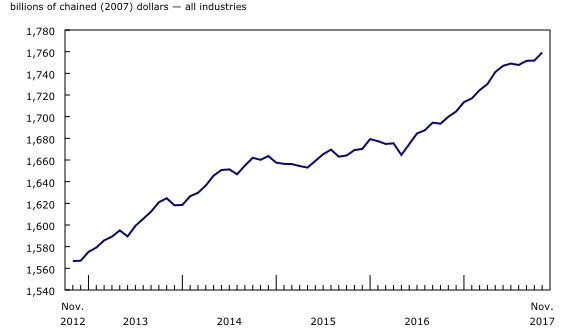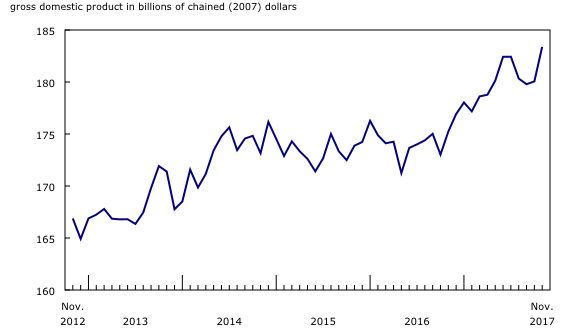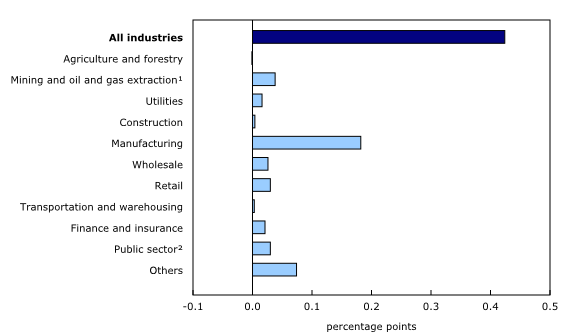Gross domestic product by industry, November 2017
Archived Content
Information identified as archived is provided for reference, research or recordkeeping purposes. It is not subject to the Government of Canada Web Standards and has not been altered or updated since it was archived. Please "contact us" to request a format other than those available.
Released: 2018-01-31
November 2017
0.4% 
(monthly change)
Real gross domestic product (GDP) increased 0.4% in November, with widespread growth across industries as 17 of 20 industrial sectors increased.
Goods-producing industries rose 0.8% after declining 0.5% in October. November's gain was mainly due to increases in the manufacturing and mining, quarrying and oil and gas extraction sectors, partly as a result of restoration in production capacity. Meanwhile, services-producing industries rose 0.3%, led by the real estate and rental and leasing, wholesale, and retail trade sectors.
Largest manufacturing growth in three years
The manufacturing sector was up 1.8% in November, the largest monthly increase since February 2014 as the majority of subsectors grew. Non-durable manufacturing rose 1.1%, while durable manufacturing jumped 2.5%.
The rise in durable manufacturing, the largest monthly increase since December 2011, was led by a 6.5% increase in transportation equipment. Following four consecutive monthly declines, which saw the industry drop by 21.5%, motor vehicle manufacturing rose 14.3% in November. Automotive vehicle assembly increased in part due to the return to production of some plant capacity following shutdowns in September and October. This increased activity was also a factor in the 8.7% rise in motor vehicle parts manufacturing in November. Miscellaneous transportation equipment rose 0.8%, while aerospace product and parts manufacturing was essentially unchanged.
There was increased output in machinery (+3.1%) and furniture and related products (+2.9%). Wood products (-0.5%) declined for the first time in five months.
Non-durable manufacturing was up for the sixth time in seven months in large part due to the 5.3% expansion of chemical manufacturing following three months of declines. Factors contributing to the growth were the end of some plant maintenance shutdowns and higher exports of pharmaceutical and medicine manufacturing products. There was growth in plastic and rubber products (+3.1%), food (+0.9%) and paper (+2.8%) manufacturing. Petroleum and coal products manufacturing declined 6.2%, the largest decrease since May 2016.
Real estate and rental and leasing continues to grow
Real estate and rental and leasing rose 0.4% in November. The output of offices of real estate agents and brokers (+4.0%) was up for the fourth consecutive month as there was increased home resale activity in Ontario and Alberta. However, the level of activity of this subsector remains below its March 2017 level, following provincial government changes to housing regulations in Ontario that came into effect in April of that year.
This increase contributed to the 0.3% rise in professional services, as legal, accounting and related services increased 0.7%. Computer systems design and related services grew 0.7%.
Mining, quarrying, and oil and gas extraction up after October decline
Mining, quarrying, and oil and gas extraction increased 0.5% in November following a 1.1% decline in October.
The oil and gas extraction subsector was up 1.6%, led by 3.7% growth in non-conventional oil extraction. The ramp-up to normal capacity continued at some facilities following maintenance turnarounds that began in mid-September. Conventional oil and gas extraction edged down 0.2%.
Mining excluding oil and gas extraction was down 2.1%, a second monthly decline after rising the six previous months. Non-metallic mineral mining was down 3.3%, due largely to a 5.7% drop in potash mining. Coal mining dropped 7.7%, while metal ore mining was down 0.7% as all industry groups declined, with the exception of iron ore mining (+4.3%).
Support activities for mining and oil and gas extraction fell 4.1% on lower drilling and rigging services. This was a seventh consecutive decline for the subsector after a string of increases that began in the spring of 2016 and ended in April 2017.
Retail and wholesale trade continue to grow
Following 1.2% growth in October, retail trade was up 0.6% in November as 7 of 12 subsectors increased. Electronics and appliance stores gained 8.4% on the strength of promotional events such as Black Friday combined with new product releases. The increases in clothing and clothing accessories (+2.1%) and general merchandise stores (+1.5%) were also influenced by promotional events. Food and beverage stores registered a 1.1% contraction as all industry groups went down. The 0.7% drop at motor vehicle and parts dealers did not offset the 3.3% growth in October.
Wholesale trade increased for the fourth time in five months, rising 0.5% as eight of nine subsectors grew. Motor vehicle and parts wholesaling (+1.6%) led the growth, reflecting increased demand from domestic manufacturing and growth in exports and imports of motor vehicles and parts. Food, beverage and tobacco (+0.9%) and personal and household goods wholesaling (+0.7%) posted gains, while petroleum product wholesaling declined 1.7%.
Finance and insurance sector resumes growth
After four consecutive months of decline, the finance and insurance sector grew 0.3% in November. Depository credit intermediation and monetary authorities and insurance carriers and related activities were both up 0.3%. Financial investment services, funds and other financial vehicles were up 0.5% following four consecutive months of decline, as market activities involving securities, mutual funds and trusteed pension assets increased.
Pipeline leak tempers growth in transportation and warehousing
Transportation and warehousing edged up 0.1% in November as five of nine subsectors grew, led by support activities for transportation (+0.8%), truck (+0.4%) and rail transportation (+1.1%). Air transportation (+0.9%) rose for a sixth consecutive month as there was increased air traffic both from Canadian travellers and travellers to Canada from other countries.
Pipeline transportation was down 3.9% as a pipeline leak in the United States in November affected exports of crude oil, resulting in a 8.1% decline in crude oil and other pipeline transportation. Pipeline transportation of natural gas was up 0.6%.
Construction edges up
Construction edged up 0.1% in November. Non-residential building construction grew 0.9%, while engineering and other construction activities edged up 0.1%. There were slight declines in residential (-0.2%) and repair (-0.2%) construction.
Other industries
Utilities were up 0.7% in November. Electric power generation, transmission and distribution was up 0.4%, while natural gas distribution rose 3.8% from higher demand across all classes of customers.
The public sector grew 0.2% in November following essentially no change in October. Educational services rose 0.2% in November after declining 0.1% in October, partly due to the increase in the universities subsector. The community colleges and CEGEPs subsector declined 0.8% in November, following a 4.6% decline in October, as a result of a five-week strike by Ontario community college faculty staff that ended on November 19, 2017 with the government of Ontario passing back-to-work legislation. In other components of the public sector, there were slight increases in health care and social assistance (+0.2%) and public administration (+0.1%).
Accommodation and food services were unchanged in November, as growth in accommodation services (+0.3%) was offset by a decline in food services and drinking places (-0.1%).
Agriculture, forestry, fishing and hunting (-0.1%) was down for the 9th time in 12 months.
Sustainable Development Goals
On January 1, 2016, the world officially began implementation of the 2030 Agenda for Sustainable Development—the United Nations' transformative plan of action that addresses urgent global challenges over the next 15 years. The plan is based on 17 specific sustainable development goals.
The release on gross domestic product by industry is an example of how Statistics Canada supports the reporting on the Global Goals for Sustainable Development. This release will be used in helping to measure the following goal:

Note to readers
Monthly gross domestic product (GDP) by industry data at basic prices are chained volume estimates with 2007 as the reference year. This means that data for each industry and each aggregate are obtained from a chained volume index, multiplied by the industry's value added in 2007. Monthly data are benchmarked to annually chained Fisher volume indexes of GDP obtained from the constant-price supply and use tables (SUT) up to the latest SUT year (2014).
For the period starting with January 2015, data are derived by chaining a fixed-weight Laspeyres volume index to the prior period. The fixed weights are 2014 industry prices.
This approach makes the monthly GDP by industry data more comparable with expenditure-based GDP data, which are chained quarterly.
All data in this release are seasonally adjusted. For information on seasonal adjustment, see Seasonally adjusted data – Frequently asked questions.
For more information on GDP, see the video What is Gross Domestic Product (GDP)?
Revisions
With this release of monthly GDP by industry, revisions have been made back to January 2017.
Each month, newly available administrative and survey data from various industries in the economy are integrated and result in statistical revisions. Updated and revised administrative data (including taxation statistics), new information provided by respondents to industry surveys, and standard changes to seasonal adjustment calculations are incorporated with each release.
Real-time CANSIM tables
Real-time CANSIM table 379-8031 will be updated on February 19, 2018. For more information, consult the document Real-time CANSIM tables.
Next release
Data on GDP by industry for December 2017 will be released on March 2, 2018.
Products
For more information about monthly national GDP by industry, see the System of Macroeconomic Accounts module on our website.
The User Guide: Canadian System of Macroeconomic Accounts (13-606-G) is also available.
The Methodological Guide: Canadian System of Macroeconomic Accounts (13-607-X) is also available.
Contact information
For more information, contact us (toll-free 1-800-263-1136; 514-283-8300; STATCAN.infostats-infostats.STATCAN@canada.ca).
To enquire about the concepts, methods or data quality of this release, contact Allan Tomas (613-790-6570), Industry Accounts Division.
- Date modified:




